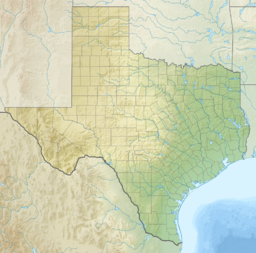geo.wikisort.org - Reservoir
Lake Fork Reservoir is a reservoir located in Wood, Rains, and Hopkins counties in the state of Texas, between the towns of Quitman, Alba, Emory, and Yantis, Texas.
This article needs additional citations for verification. (December 2021) |
| Lake Fork Reservoir | |
|---|---|
 Marshy inlet on Lake Fork | |
 Lake Fork Reservoir  Lake Fork Reservoir | |
| Location |
|
| Coordinates | 32°48′15″N 95°32′22″W |
| Type | reservoir |
| Part of | Sabine River |
| Primary inflows |
|
| Primary outflows | Lake Fork Creek |
| Catchment area | 493 sq mi (1,280 km2) |
| Basin countries | United States |
| Surface area | 27,264 acres (11,033 ha)[1] |
| Max. depth | 70 feet (21 m)[1] |
| Water volume | 675,819 acre-feet (833,610,000 m3) |
| Shore length1 | 315 miles (507 km) |
| Surface elevation | 403.0 ft (122.8 m) |
| Website | www |
| 1 Shore length is not a well-defined measure. | |
It was impounded by the Lake Fork Dam in 1980, and reached its normal pool surface elevation of 403.0 feet (122.8 m) above mean sea level[1] in 1985. It consists of 27,264 acres (110.33 km2),[1] offers 315 miles (507 km) of shoreline, and has a drainage area of 493 square miles (1,280 km2). The dam is 12,410 feet (3,780 m) in length and impounds Lake Fork Creek, a tributary of the Sabine River, and other major creeks are Big Caney and Little Caney.
The dam and reservoir with a maximum capacity of 675,819 acre-feet (833,610,000 m3) are owned and operated by the Sabine River Authority, a state agency.
It officially serves as a reservoir for Dallas and its suburbs.[2] However, it is best known for its fishing, as it holds 15 of the top 20 Texas State Record largemouth bass ever caught, making it one of the premier trophy bass fishing lakes in the world.
Fishing
Lake Fork Reservoir was created as a textbook fishery, including initial stockings before the lake filled. Lake Fork Reservoir was established, by the Texas Parks and Wildlife, as a premier bass fishing lake, with 732,514 Florida-strain largemouth bass being stocked from 1979 through 1987. Lake Fork Reservoir offers excellent fish habitat with 80% standing timber left intact, and hydrilla, milfoil, and duckweed being the predominant vegetation. Other species of fish include catfish, sand bass, yellow bass, black and white crappie, sunfish, bowfin, gar, and bluegill. The predominant food source for the larger fish is shad, minnows, and crawfish.
To preserve the great Lake Fork Reservoir bass fisheries, the Texas Parks and Wildlife implemented a protected slot limit of no bass between 16 to 24 inches (410 to 610 mm) will be kept, and will be returned into the waters of Lake Fork immediately. A five bass per day limit can be kept, consisting of five-under 16 inches (410 mm), or one-over 24 inches (610 mm) , and four-under 16 inches (410 mm).[3]
References
- "Lake Fork". Texas Parks and Wildlife Department. n.d. Archived from the original on 27 November 2021. Retrieved 16 December 2021.
- "Lake Fork begins supplementing Dallas water supply". The Dallas Morning News. 1 January 2010. ISSN 1553-846X. Archived from the original on 16 December 2021. Retrieved 16 December 2021.
After decades of planning, years of construction and hundreds of millions of dollars in costs, water is finally beginning to flow out of Dallas taps from Lake Fork, in East Texas.
- "Fishing Regulations for Lake Fork". Texas Parks and Wildlife Department. n.d. Archived from the original on 1 November 2020. Retrieved 16 December 2021.
Resources
- source: Army Corps of Engineers, and USGS
External links
Другой контент может иметь иную лицензию. Перед использованием материалов сайта WikiSort.org внимательно изучите правила лицензирования конкретных элементов наполнения сайта.
WikiSort.org - проект по пересортировке и дополнению контента Википедии
